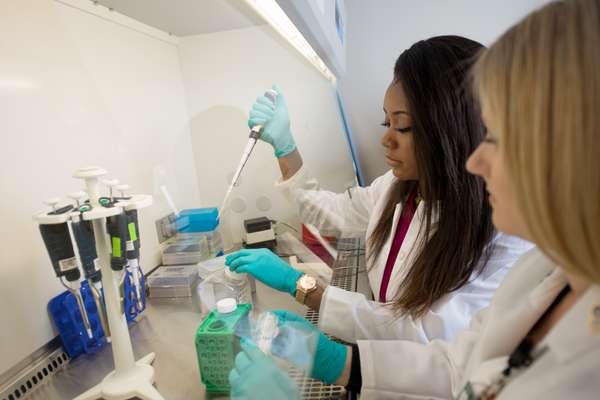Researcher using engineering and medical skills to help people with type 1 diabetes

By the time she was a college sophomore, LaDonya Jackson already was cloning horses in a lab at Utah State University. She thought her interest in this research stemmed from her childhood dream of becoming a veterinarian, but she quickly realized that's not what excited her about the work.
"I thought I was interested in the animal aspect of animal cloning. I found out it was the technology and engineering applications to medicine that I was interested in; that's when I began working in that field," she recalls.
Jackson, now a second-year graduate student in biomedical engineering at Ohio University, has turned her laboratory skills to developing a diagnostic assay (a test used to diagnose different biological states) that can detect the early onset of type 1 diabetes.
She is working with two mentors from the Heritage College of Osteopathic Medicine, Kelly McCall, an associate professor of endocrinology, and Frank Schwartz, a professor of specialty medicine, to create a test that can detect the disease before it causes irreparable damage to the pancreas.
Early detection of the disease will allow patients to begin treatment regiments earlier, hopefully resulting in better clinical outcomes for the patients, McCall says.
Preventing cell loss
Type 1 diabetes is characterized by a loss of pancreatic beta cells, Jackson says. They are responsible for producing insulin, which the body needs to utilize the glucose obtained through food. Current diagnostic tests for type 1 diabetes can detect the disease only after 50-70 percent of the pancreatic beta cells have been destroyed.
"The diagnostic assay we're hoping for will be able to detect diabetes early on before the major loss of the beta cells in the pancreas," Jackson notes.
Early detection and medical intervention could result in preserving the body's natural ability to produce insulin, meaning less overall medical treatment for the patient.
"If the destruction of beta cells can be halted before major damage is done, patients will have the possibility to live natural lives without the worry of insulin injections and blood glucose problems," she says.
Jackson began designing the diagnostic test in June 2013. By the end of the summer, she was testing the assay using cell cultures. The results were promising; the cell cultures have shown a high sensitivity and high specificity, indicating a good probability that the assay can detect early onset type 1 diabetes. These results prompted the move to animal trials in spring 2014.
Jackson concluded a 24-week study in November of 48 mice with a genetic predisposition to spontaneously develop type 1 diabetes. Though still analyzing her data, she is hopeful the results will show that the assay detected which mice were developing diabetes early in the study.
Merging medicine with engineering
Jackson decided to pursue her graduate education at Ohio University because of the integrated nature of the biomedical engineering program, which is housed in the Russ College of Engineering and Technology but has synergies with several other academic colleges and institutes on campus, including the Heritage College of Osteopathic Medicine.
"If you are creating a diagnostic assay, you have to use both medical and engineering applications. It has the possibility for direct application to impact the lives of patients," she says.
After she graduates from Ohio University, Jackson will pursue a dual doctoral degree in medicine and philosophy. She plans to become a reproductive endocrinologist and pursue research on in vitro fertilization, embryonic stem cells, and epigenetics, the study of heritable changes that are not caused by changes in the DNA sequence.
As for her current research, Jackson will continue working with her mentors to study the effectiveness of her assay in the hope that it will one day be available to the public.
"LaDonya's research is important because it may not only lead to a better understanding of how type 1 diabetes develops," McCall says, "but may also provide a novel and much improved method for diagnosing this disease earlier, which may help to prevent the progression of the disease and/or delay its onset."



















